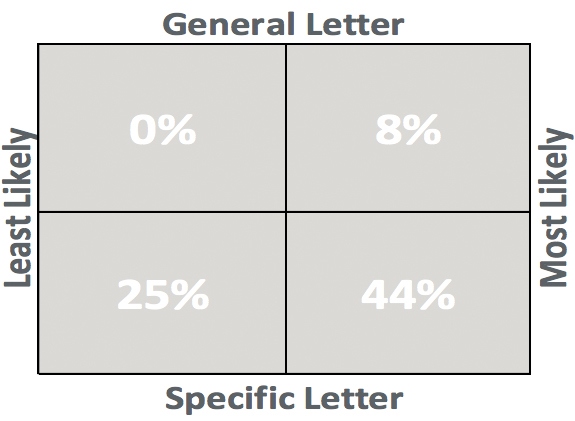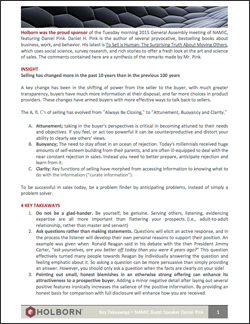Holborn was the proud sponsor of the Tuesday morning 2015 General Assembly meeting of NAMIC, featuring Daniel Pink. Daniel H. Pink is the author of several provocative, bestselling books about business, work, and behavior. His latest is To Sell is Human: The Surprising Truth About Moving Others, which uses social science, survey research, and rich stories to offer a fresh look at the art and science of sales. The comments contained here are a synthesis of the remarks made by Mr. Pink.
INSIGHT
Selling has changed more in the past 10 years than in the previous 100 years
A key change has been in the shifting of power from the seller to the buyer, with much greater transparency, buyers have much more information at their disposal, and far more choices in product providers. These changes have armed buyers with more effective ways to talk back to sellers.
The A, B, C’s of selling has evolved from “Always Be Closing,” to “Attunement, Buoyancy and Clarity.”
A. Attunement; taking in the buyer’s perspectives is critical in becoming attuned to their needs and objectives. If you feel, or act too powerful it can be counterproductive and distort your ability to clearly see others’ views.
B. Buoyancy; The need to stay afloat in an ocean of rejection. Today’s millennials received huge amounts of self-esteem building from their parents, and are often ill-equipped to deal with the near constant rejection in sales. Instead you need to better prepare, anticipate rejection and learn from it.
C. Clarity; Key functions of selling have morphed from accessing information to knowing what to do with the information (“curate information”).
To be successful in sales today, be a problem finder by anticipating problems, instead of simply a problem solver.
4 KEY TAKEAWAYS
1. Do not be a glad-hander. Be yourself; be genuine. Serving others, listening, evidencing expertise are all more important than flattering your prospects. (i.e., adult-to-adult relationship, rather than master and servant)
2. Ask questions rather than making statements. Questions will elicit an active response, and in the process the listener will develop their own personal reasons to support their position. An example was given when Ronald Reagan said in his debate with the then President Jimmy Carter, “ask yourselves, are you better off today than you were 4 years ago?” This question effectively turned many people towards Reagan by individually answering the question and feeling emphatic about it. So asking a question can be more persuasive than simply providing an answer. However, you should only ask a question when the facts are clearly on your side!
3. Pointing out small, honest blemishes in an otherwise strong offering can enhance its attractiveness to a prospective buyer. Adding a minor negative detail after laying out several positive features ironically increases the salience of the positive information. By providing an honest basis for comparison with full disclosure will enhance how you are received.
4. In predicting a buyer’s likely response, salespeople tend to overemphasize the buyer’s likely predisposition, whereas the context has more influence in driving their behavior. An example was cited where college students were approached for involvement in a charitable activity. The study consisted of two groups of students and two different approaches:
Two groups of students:
1. Least likely to get involved
2. Most likely to get involved
Two different approaches were taken
1. General letter to each of the two student groups
2. Specific letter to each group.
The difference being that the specific letter provided details of ways to get involved that was clear and easy to act upon. The uptake from each of the four categories of respondents surveyed was as follows:



